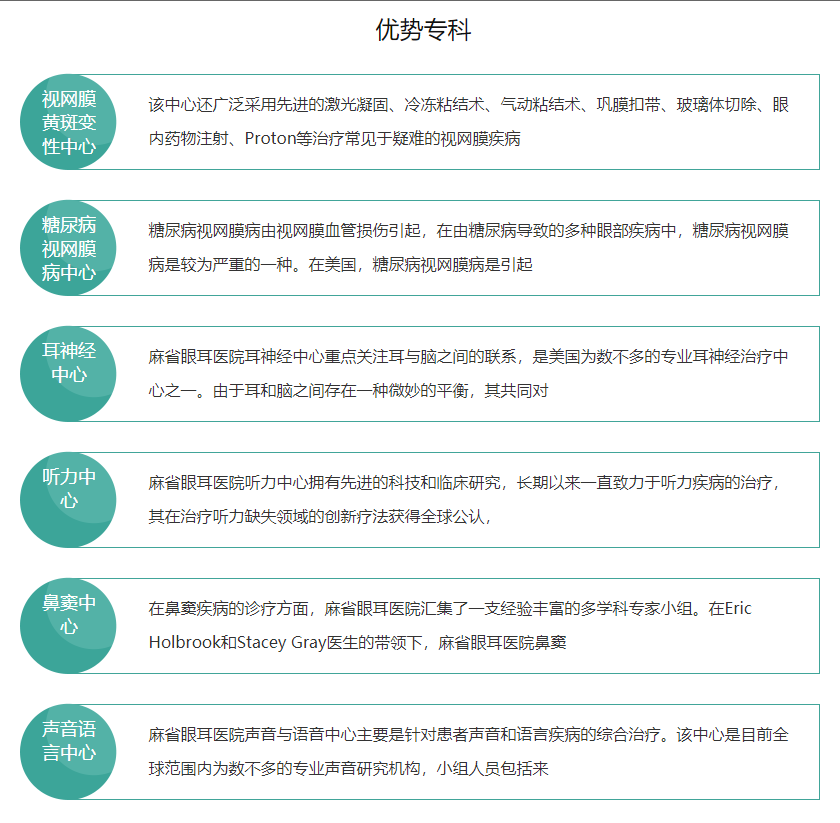9F, Zhongrui Jumei Building, 68 Jiuzhang Road, Suzhou Industrial Park, Jiangsu Province
USA
Massachusetts Eye and Ear Hospital
Massachusetts Eye and Ear Hospital is a specialized hospital for the treatment of eye, ear, nose, throat, and head and neck diseases. It is also an affiliated teaching hospital of Harvard University Medical School. Through resident doctors and clinical scientific research, it has trained many medical talents in ophthalmology and otolaryngology. The Institute was established in 1824 by Edward Reynolds and Dr. John Jeffries, and has received international recognition since its establishment. Adjacent to the Massachusetts General Hospital area. From 2016 to 2017, the Massachusetts Eye and Ear Hospital ranked top in the treatment of ear, nose, and throat diseases in the United States for two consecutive years, and the treatment of eye diseases ranked first in New England (US News and World Report)
The hospital has won wide international recognition for its advantages in treating complex diseases of the eyes, ears, nose, throat, and head and neck, as well as its outstanding contributions to medical research and education. Diagnosis and treatment services include: eye tumor, diabetes eye disease, macular degeneration, glaucoma, neuroophthalmology, immunology and uveitis, cataract surgery, laser vision correction surgery, pediatric ophthalmology and strabismus; Hearing correction and improvement, ear, nose, and throat tumors, facial plastic surgery, head and neck surgery, hyperbaric oxygen therapy, laryngeal science and sound, neurootology and vestibule, pediatric ear, nose, and throat diseases, sleep disorders, snoring, facial nerve disorders, thyroid diseases, and skull base tumors
The hospital provides high-quality medical solutions and considerate services to patients. The hospital will provide assistance to patients as much as possible based on their own choices. To this end, a patient guidance center has been established, providing a list of hotels and other accommodation information for patients who are farther away from Boston. Massachusetts Eye and Ear Hospital has 18 branch hospitals throughout eastern Massachusetts and Rhode Island, with each branch providing different services. Support groups and disease specific information groups have also been established to help guide patients and their families or provide psychological support
The retinal center and macular degeneration center of the hospital are the first to apply OTC inspection technology in the world; First, photodynamic therapy was used to treat wet macular degeneration; Firstly, Macugen was developed for the treatment of wet macular degeneration; Lucentis was first used to treat age related wet macular degeneration (AMD). Advanced laser coagulation, cryosurgery, pneumatic bonding, scleral buckling, vitrectomy, intraocular drug injection, Proton, and other methods are widely used to treat common and difficult retinal diseases; In addition, laser, intravitreal injection of Kenalog, intravitreal injection of Avastin and vitrectomy were used to treat diabetes retinopathy
The landmark achievements of the Massachusetts Eye and Ear Hospital are as follows:
In 1888, Clarence John Blake, a professor of otology at Harvard Medical School, made significant contributions to hearing research, and also invented a middle ear endoscope to remove ear polyps
In 1958, the world's largest auditory physiology research laboratory was established
In 1975, a drug that can treat herpes simplex was discovered to prevent blindness caused by infection of the cornea
In 1975, proton radiation therapy was used to treat intraocular malignant melanoma
In 1982, the technology for diagnosing neonatal hearing loss was invented, and now it is widely used worldwide
In 1986, the gene controlling retinoblastoma was isolated
In 1989, a gene causing retinitis pigmentosa was isolated
In 1993, he invented a surgical method for recovering language, swallowing, and normal breathing in patients with vocal cord paralysis
· In 1994, it was found that VEGF is a molecule that causes diabetes retinopathy and age-related macular degeneration
In 1995, the United States High Pressure Oxygen Service Center was established; First, photodynamic therapy was used to treat neovascular macular degeneration, which was approved by the FDA in 2000
In 2003, stem cells that can be transformed into mature auditory hair cells were discovered in the inner ear, which is expected to become a new method for restoring hearing
Evangelos S. Gragoudas is an expert in the treatment of proton in the eye. He served as the director of ophthalmology and has a high reputation in the field of intraocular tumor treatment. In 1994, he served as a professor of ophthalmology at Harvard Medical School, and from 2002 to 2003, he served as the chairman and executive director of the ophthalmology department at Harvard Medical School. He was committed to research on proton therapy. His research results show that proton therapy is not only safe and effective, but also an effective alternative therapy for enucleation of the eyeball
Professor Joan W. Miller is currently the director of ophthalmology at the Massachusetts Eye and Ear Hospital, specializing in the treatment of retinal and vitreous diseases and surgery; Age related macular degeneration; Diabetes retinopathy; Photodynamic therapy, etc
Professor Joseph B. Nadol is the Director of the Otolaryngology Department of the Eye and Ear Hospital, and also the Director of the Otolaryngology Department of the Harvard Medical School in the United States. He enjoys a high reputation for treating hearing loss



